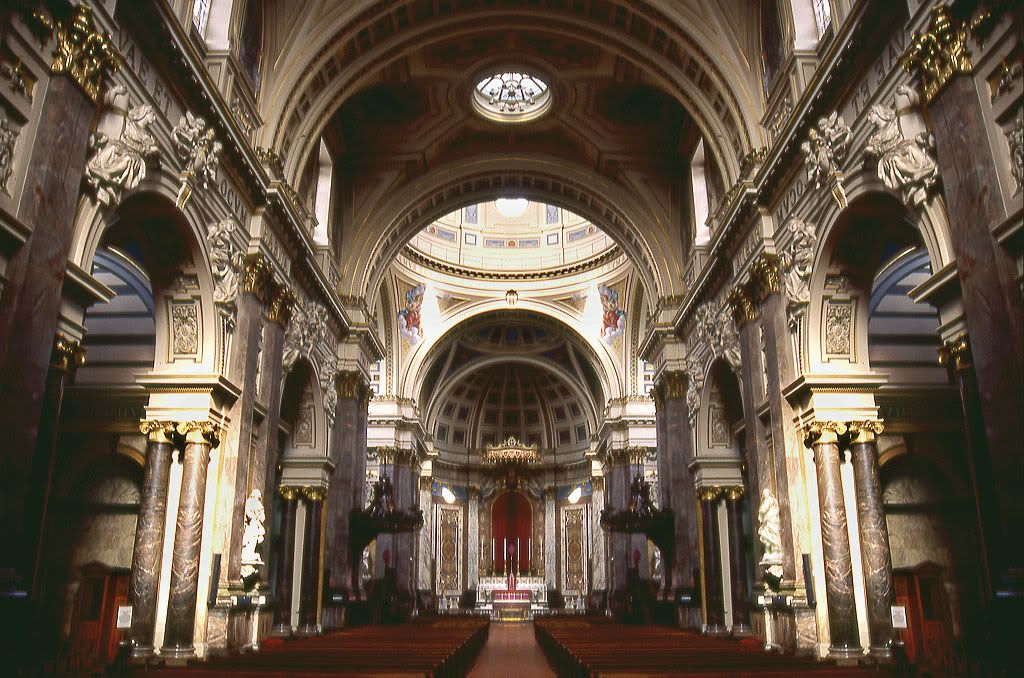The morning prayers and communion were very different from the style of worship that I'm familiar with, naturally, but I still felt that there was a special feeling present during the services. There's a certain sense of sacredness that comes with that place because the abbey has been a place that so many thousands of people have gone to try to get closer to God. It's a different kind of sacredness than we're used to in the LDS Church, but I still found it very moving.
After we were finished at Westminster Abbey, we went to the Brompton Oratory (or the Church of the Immaculate Heart of Mary). It's a Catholic church, and the first Catholic church I've been in (possibly ever, but certainly) since I arrived in London—the rest have been Anglican. It was very different in style from the other churches I've visited, but still very beautiful.
While visiting both of these churches, I found myself reflecting on a lot of things. First of all, it was so moving to see people worshiping in each of these locations, although it was somewhat sad to walk into these enormous halls with so many seats, and then to see only a few people participating. Ben's project can say a lot more about dwindling religiosity in London than I can, but it's fairly apparent to me that, for all the presence of these enormous houses of worship, religion is not popular among the residents.
Secondly, during this past semester in my Christian History class with Brother Gaskill, we talked about the minimal numbers of people who choose to become clergy in major religions, most notably Catholicism and Eastern Orthodox. It seems that this trend is also occurring in the Anglican Church, because the majority of their clergy are quite old. That being said, it warmed my heart a little bit to see a much younger man among their ranks yesterday—it's such a great sacrifice, and somewhat comforting to see someone willing to make it.
The third thing I spent a lot of time thinking about was the level of ornateness present in each of these churches. As I've visited each of them and taken note of how they are decorated and designed, I've spent a lot of time thinking about the symbolic nature of these various things. All the while, I kept having this same idea run through my head that has been thrown at me from so many different people: the idea that other churches whose meetinghouses are so ornate are "gaudy" and that this somehow is indicative of them being less true than our church, which in comparison is much more minimalist in design. Although I've always been taught to be respectful of other religions and to appreciate the beauty in these things, somehow this idea got slipped in there as well.
And perhaps there is some truth to it. I'm thinking particularly of Nephi saying that his "soul delighteth in plainness" which may simply be a words/scriptures/doctring reference, but which could potentially be applied to other aspects of worship (2 Ne. 25:4) ... Or perhaps it's our just our Protestant background informing us that "'tis a gift to be simple" that makes our buildings seem so plain in comparison.
I just kept thinking, as I was sitting in these churches, that they employ many of the same architectural and decorative strategies that we do in our meetinghouses and temples to symbolize aspects of our faith, especially symbolizing the path to return to God. We might see the bright colors and statues and paintings and vaulted ceilings and filigrees and columns and molding as being "gaudy" in comparison to what we're used to. But don't we employ spires and paintings and colors and staircases and various forms of decor to carry symbolic meaning? Don't we also focus on having everything be of the highest quality in a building that we're dedicating to the Lord?
I guess what I'm saying is that it seems to me that it's simply different interpretations and applications of similar principles: creating symbolic meaning in our places of worship. This might not be the most incredibly insightful post, but I spent so much time thinking about it yesterday, trying to understand what was so wrong about the so-called gaudiness of these buildings, trying to reconcile what I'd been taught with what I was experiencing, that it felt like a bigger realization than it was since now it seems like an obvious thing.
In other news, today is the 20th of June. Do you know what this means? It means I've been here for six weeks. It also means that in approximately 24ish hours, I will have been in London for 45 days. And that means that I only have 45 days more to go in London ...
... which means this Field Study is halfway over, y'all. :)


